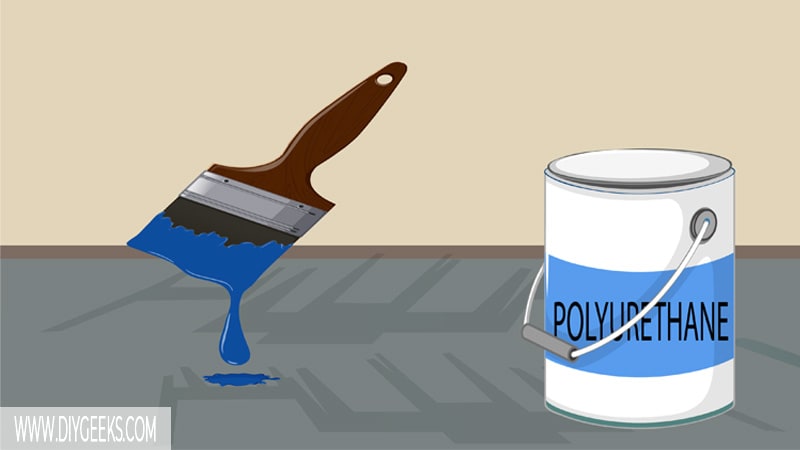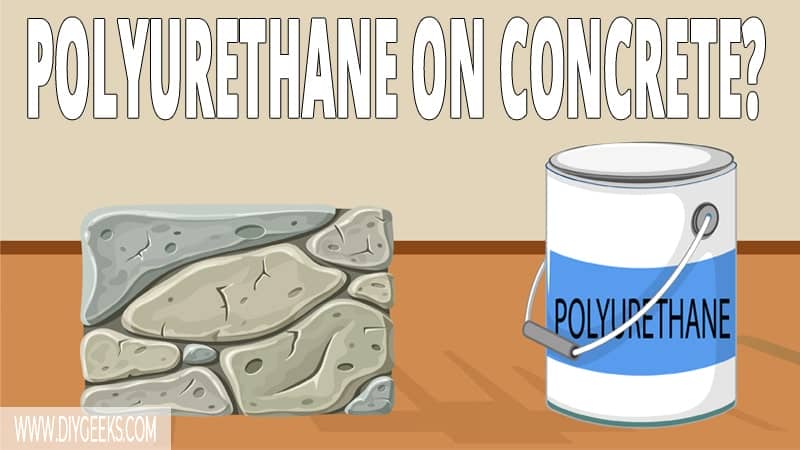Polyurethane sealers protect the surface underneath from water, moisture, scratches, and more.
To apply polyurethane on concrete, clean the surface, wait for the surface to dry, use a concrete filler (if needed), mix (stir) the polyurethane, and apply it.
Can You Apply Oil-based Polyurethane To Concrete?
You can apply oil-based polyurethane to concrete as it has impressive adhesion qualities. It will produce a tough layer and last longer because it uses oil as its solvent.
Since oil takes longer to evaporate, its paint particles have more time to harden before drying. This results in a tougher and more durable coating. However, this also means the sealer takes longer to dry.
For outdoor concrete, use exterior polyurethane as it’s UV resistant and has more additives to protect the surface from weather elements (rain or sun).
Interior polyurethane doesn’t have UV-resistance so its finish won’t last long if applied outdoors. Rain and sun will slowly dissolve the coating and remove it.
Related Read: How To Paint Over Concrete Sealer?
Varathane vs. Varnish Polyurethane (For Concrete Surfaces)
Don’t use varathane polyurethane over concrete as it will produce a yellow-tinted finish, doesn’t stick well to self-leveling surfaces, and isn’t as durable.
You can use varathane polyurethane for indoor low-traffic surfaces only.
Use Varnish polyurethane for outdoor surfaces as its finish self-levels, penetrates the surfaces better, and protects it from dust, debris, water, moisture, and scratches.
How To Apply Polyurethane On Concrete?

To apply polyurethane on concrete, do the following.
1. Clean the Concrete
To clean un-painted surfaces do the following.
- Pour mineral spirits over oil spills, stains, or dirt.
- Use a cleaning brush to scrub the surface.
- Once the surface is clean, remove the residue of the mineral spirit with clean water.
You can use TSP or pre-paint cleaner as an alternative to mineral spirits.
To clean painted surfaces do the following things.
- Use soapy warm water or TSP.
- Pour the soapy water over the concrete and use a soft brush to scrub the dirt.
- After you remove the dirt, clean the soap residue with clean water.
To clean concrete floor do the following things.
- Use a concrete cleaner.
- Use a scrubbing broom, and scrub the dust off the floor.
- To be more efficient, work in batches across the room. Or, buy a kit to resurface the floors.
- Water down the whole floor with clean water.
2. Wait For the Concrete To Dry
To remove the cleaner residue from the surface, use a power washer, or water hose.
Once its surface is clean and the cleaner residue is removed, wait until it dries. To speed up its drying process, squeeze the water off the surface. However, you still must wait 1-3 days for the concrete to dry.
3. Use Concrete Filler
If the surface is cracked, has holes, or is damaged, you must fix it before sealing it. If you don’t, the sealer will soak into the holes and create an uneven finish.
To repair cracks on a surface do the following.
- Use concrete filler or restoration caulk.
- Squeeze the caulk into the cracks or holes and fill up as much as possible; don’t leave gaps between cracks, and fill the holes full.
- Use a towel to remove the excess restoration filler, and let it dry.
4. Mix the Polyurethane
Before applying polyurethane, you must stir (or mix) it. To mix it, use a turning stick to stir the sealer for 5 minutes. Don’t stir too hard because air can get trapped inside the container, and you will get a bubbled finish.
If you don’t mix it, the finish will be inconsistent and won’t dry properly.
5. Apply The Polyurethane
To apply polyurethane, use a paint roller or paintbrush. For small surfaces, use a paintbrush. For larger surfaces, use a paint roller. Pour a small amount of polyurethane over the large floor, then use a paint roller to spread it equally.
You must apply 1-2 coats for low-traffic surfaces and 3-4 coats for high-traffic surfaces. Wait until one coat dries before applying the next one. If you re-coat too soon, the finish will turn sticky and might peel off.
How Long Does Polyurethane Last Over Concrete?
Water-based polyurethane lasts up to 5 years, while oil-based polyurethane lasts 10 years over a concrete surface.
However, the durability of the sealers also depends on how much the surface is used. For high-traffic concrete, the sealer won’t last more than 3-4 years. For low-traffic surfaces, it will last up to 10 years.
The finish will last less if the surface is exposed to rain. That’s because polyurethane is only water-resistant, not waterproof. So, after a while, the rain will dissolve it and expose the surface underneath to water.
[su_youtube url=”https://www.youtube.com/watch?v=3Pe_RFEj6oc”]
Related Read: How To Apply Polyurethane on Metal?


